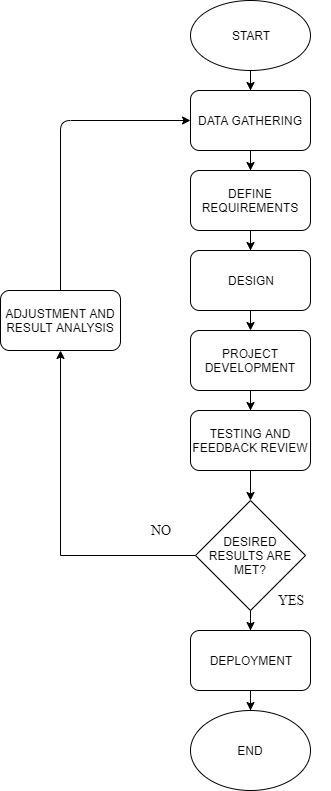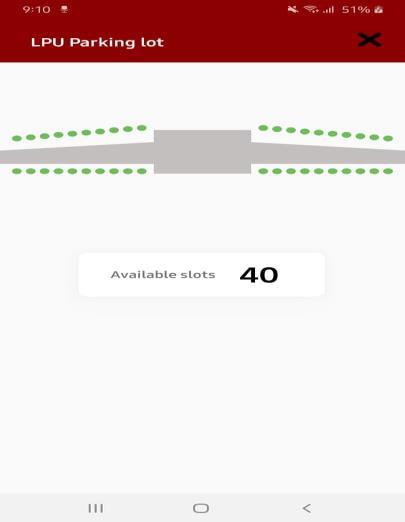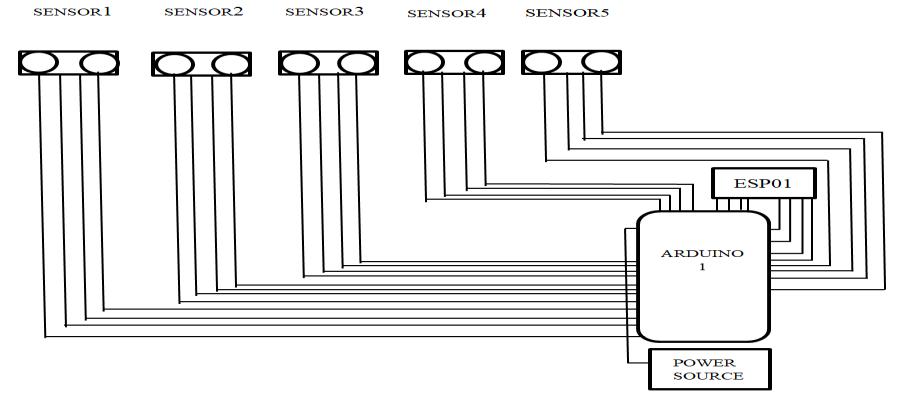ISSN 2348-1196 (print)
International Journal of Computer Science and Information Technology Research ISSN 2348-120X (online) Vol. 9, Issue 1, pp: (117-122), Month: January - March 2021, Available at: www.researchpublish.com

ISSN 2348-1196 (print)
International Journal of Computer Science and Information Technology Research ISSN 2348-120X (online) Vol. 9, Issue 1, pp: (117-122), Month: January - March 2021, Available at: www.researchpublish.com
College of Engineering, Computer Studies, and Architecture Lyceum of the Philippines University - Cavite
Abstract: The purpose of this study is to design an Android based application for Realtime Monitoring of the parking lots of Lyceum of the Philippines University – Cavite; this study is beneficial to the LPU Cavite, car owners, parking lot staffs and future researchers. The study would serve as a pattern and guide for future researchers who want to develop a real time monitoring application. The researchers developed an Android application that provides real time parking availability to help reduce the inconvenience parking occupants’ experiences in Lyceum of the Philippines University –Cavite.
Keywords: LPU-Cavite, resort Campus, Real-time, Internet, parking, android application.
The Philippines is currently struggling with different issues. The most common problem that Filipinos wanted to be solved is about the traffic and parking. The former is something the government has been dealing with for a long time while the latter still need to be addressed. As a developing country, the Philippines need to have a better parking system immediately in order to lessen the traffic that may be caused by looking for a parking space. As the years go by, many Filipinos want to have their own car so that the travelling process will be easy. Little they know that having more cars causes more traffic. Finding an available space to park one’s car is a major problem especially to those areas that are already well developed. Some establishments have a little parking lot that the car owners need to park somewhere else. In a transportation system, parking is an essential element. If a driver arrives to a desired destination, parking is a necessity. An ordinary car is usually parked for 23 hours per day and occupies several parking spaces every week. [1]One of the main types of land use is a parking facility; their design and location have an influence on the type of development that is taking place as well as on how they view the building or use the road. Parking is usually the first and last engagement that people have with a destination, and therefore has a major impact on their experience. A real-time monitoring Android application is a system and a tool that will assist the end-user that will let them recognize the exact location of the available slot by accessing the application. A pre-survey was conducted on the parking of LPU –Cavite in which the results showed that 75% of the parking occupants use mobile android phones, 21% is IOS phone users and the 4% uses both. It is proven that the Android users are higher compared to IOS users. This tool helps a lot in saving time looking for parking spaces because the users will be given real time information on the specific parking lot.
[2]Machine vision systems have less expenditure and resistance to the environment conditions. It makes it very suitable for open parking lots. For closed parking lots, magnetometers or sensors are commonly used. Real time parking system provides information that will distribute the shortest route for free parking slots. Finding an open parking space is frustrating, a waste of time and gas just going to shopping, school, and workplace. Parking management and monitoring
ISSN 2348-1196 (print)
International Journal of Computer Science and Information Technology Research ISSN 2348-120X (online) Vol. 9, Issue 1, pp: (117-122), Month: January - March 2021, Available at: www.researchpublish.com
system is getting bad in University Campuses for students and school staffs. In order to respond to the number of users in an android platform the authors used Client servers. [3]Using Smartphone applications with real time parking information for parking space availability. Through the mobile application, the available free parking space can be viewed in real time. [4]It is a must to monitor air pollution because according to the researchers’ survey, the car that is looking for a parking space can travel the world 38 times and consumes about 1.7 liters of fuel and generates 730 tons of carbon dioxide. [5]Smart City Paradigm offers smart parking, it plays a huge role because it has a portion of the city’s space
The proponents used a qualitative and quantitative type of research method. The collection of qualitative data is gathered through researching related articles and related studies. Qualitative research is a kind of research where the researchers collect and work with non-numerical data and use it to figure out how the study will help those target populations or places. The quantitative data are attained through measuring distances and analyzing the results by numerical comparisons.
Instrumentation:
Ultrasonic Sensor
Arduino Mega
Power Supply
Wifi Module
LoRa Device
FTDI Adapter
Galvanize Iron Pipe
Router
An agile system method model for it is the most suited model for the study. The said system model is a combination of incremental and iterative which supports the project to be able to adapt to adjustments quickly. It involves different stages such as requirements, design, develop, test, deploy, and review. Fig.1 Project Construction Flowchart

ISSN 2348-1196 (print)
International Journal of Computer Science and Information Technology Research ISSN 2348-120X (online) Vol. 9, Issue 1, pp: (117-122), Month: January - March 2021, Available at: www.researchpublish.com


The ultrasonic sensor will serve as the input of the system, the sensor will detect if there is any obstacle within the programmed range. The arduino will analyze the data processed by the sensor and send signals to the ESP01 Wi-Fi module. The system output will be printed to the online database and will be displayed through the Android application. Fig.4 Project

ISSN 2348-1196 (print)
International Journal of Computer Science and Information Technology Research ISSN 2348-120X (online) Vol. 9, Issue 1, pp: (117-122), Month: January - March 2021, Available at: www.researchpublish.com
TABLE I: THIS TABLE PRESENTS THE RESULTS OF THE SURVEY MARS EVALUATION SCORES OF RESPONDENTS OF LPUPARKN’ GO MOBILE APPLICATION
Statements Mean
Functionality
Reliability
Accurateness
Information
1. The app features (functions) and components (buttons/menus) work appropriately 3.9
2. Moving between screens is logical/accurate appropriate/uninterrupted; all screen links presented are necessary. 3.66
3. Interactions (taps/swipes/pinches/scrolls) are consistent. 3.93
4. The Mobile Application runs continuously with no errors. 3.93
5. The mobile application provides consistent results after repetitive testing. 4
6. The Mobile Application shows the correct information whether the parking spot is occupied or unoccupied. 3.93
7. The app contains features and functions based from its descriptions. 3.86
8. The content is correct and relevant to the goal/topic of the app. 4
9. The visual concepts – through figures/images, etc. is clear, logical and correct. 3.9
Usability
10. The mobile application instruction is easy to understand. 4
11. The buttons are easily pressed (taps/swipes/pinches/ scrolls). 3.86
12. The mobile application is easy to operate. 3.7
Engagement
Aesthetics
13. The app is interesting to use 3.73
14. The mobile application content (visual information, language, design) is appropriate for the target user/audience 3.63
15. Arrangement and size of icons/contents on the screen are appropriate or able to zoom if needed. 3.93
16. The mobile application looks good. 3.36
17. Quality of graphics. 3.4
ISSN 2348-1196 (print)
International Journal of Computer Science and Information Technology Research ISSN 2348-120X (online) Vol. 9, Issue 1, pp: (117-122), Month: January - March 2021, Available at: www.researchpublish.com
TABLE IV: ACCURACY RESULTS FOR ULTRASONIC SENSORS AND VIEW PARKING Detection of object within 100cm distance Detection of object higher 100cm distance
This study was able to meet the three (3) primary objectives defined in providing convenience in looking for empty parking space whenever one goes to any establishments.The primary objective of designing an Android based application for real time monitoring of parking lots of Lyceum of the Philippines University – Cavite was achieved by installing sensors on each parking space to monitor parking space occupancy at any given time. These sensors were hooked up to an Arduino IDE software that processed the data provided by the sensors which were then displayed and processed on the Android application for monitoring. By successfully connecting these sensors to the Arduino IDE software, and linking them to the Android software developed, the first and the secondary objectives of the study were successfully met. Lastly, the system was tested based on 4 characteristics namely, accuracy, functionality, reliability and usability. Accuracy was successfully demonstrated when the sensors were able to detect obstruction when it was within the defined range, and cleared when it was outside its range. This was demonstrated on multiple trials and showed successful results. Functionality was also validated when the android program was repeatedly downloaded, used and functioning very well. Reliability was also a non-issue as the testing showed repeatable results on multiple occasions the program was tested. Lastly, usability was determined by a user survey MARS for 30 respondents and found the application to be highly acceptable. Overall, the study which resulted in the end product of “LPU Park’n Go: An Android Application for Realtime Parking Availability in Lyceum of the Philippines University –Cavite” successfully met all the defined objectives and thereby concluded as successful.
ISSN 2348-1196 (print)
International Journal of Computer Science and Information Technology Research ISSN 2348-120X (online) Vol. 9, Issue 1, pp: (117-122), Month: January - March 2021, Available at: www.researchpublish.com
The researchers would like to express their sincerest gratitude to everyone who significantly contributed to the success of this study. First and foremost, their thesis advisor, Eng. Rhia Espanto for the continuous support to the thesis project, for his patience, motivation, and immense knowledge. They also express their gratitude to their thesis panelists, Engr. Jocelyn Bernardino, Engr. Leah Santos and Engr. Joshua Salazar, for giving encouragement, insightful comments, pieces of advice, and constructive criticisms for the improvement of the study. The researchers would also like to thank the Lyceum of the Philippines University - Cavite Campus, for being a source of references regarding how to conduct a thesis and as well as a source for related studies. Lastly, their thanks and appreciation also goes to the families, friends, classmates, and batch mates, for supporting and helping them financially, emotionally, and also providing ideas regarding the study.
[1] Lim et al (2018). IoT – Based Car’s Parking Monitoring System. Retrieved from https://www.matecconferences.org/articles/matecconf/abs/2018/23/matecconf_icesti2018_01002/matecconf_icesti2 018_01002.html
[2] Paidi et al (2018). Smart parking sensors, technologies and applications for open parking lots: a review. Retrieved from https://www.semanticscholar.org/paper/Smart-parking-sensors%2C-technologies-and-for-open-%3 A-Paidi-Fleyeh/5f78d24a49236001b02774c47ca2874ed8459cd5
[3] C Dela Cruz (2016). Smart urban parking detection system. Retrieved from https://www.semanticscholar.org/paper/ Smart-urban-parking-detection-system-ZadehCruz/7bf036410a118668dc5009d7dfd2f6ac4590ff07
[4] Shaik et al (2016). Smart Parking System Based on Embedded System and Sensor Network. Retrieved from https://www.ijcaonline.org/research/volume140/number12/shaikh-2016-ijca-909532.pdf
[5] Faraji (2019). Smart Parking: an efficient approach to city’s smart management and air pollution reduction. Retrieved from https://publish.kne-publishing.com/index.php/JAPH/article/view/603
[6] D.C Karia et al (2015). Cloud Based Smart Parking System. Retrieved from https://ieeexplore.ieee.org/abstract/document/8473084
[7] Dr. Kepuska 2016. Smart Car Parking System. Retrieved from https://www.researchgate.net/publication/ 319345084_Smart_Car_Parking_System
[8] Dr. Solanki et al (2017). Smart City: IOT Based Prototype for Parking Monitoring and Management System Commanded by Mobile App. Retrieved from https://annals-csis.org/Volume_10/pliks/23.pdf
[9] Elid.com.ph (2019). Parking System Philippines. Retrieved from https://elid.com.ph/parking-system-philippines/
[10] Faraji (2019). Smart Parking: an efficient approach to city’s smart management and air pollution reduction. Retrieved from https://publish.kne-publishing.com/index.php/JAPH/article/view/603
[11] Marcos Lopez et al (2019). Parking Lot Occupancy Tracking Through Image Processing. Retrieved from https://wvvw.easychair.org/publications/download/2STV
[12] Yap (2018).The Future of Parking. Retrieved from https://www.manilatimes.net/2018/11/19/business/columnistsbusiness/the-future- of-parking/469981